How This Brooklyn Craft Brewery Built a Cult Following
With 100,000 Instagram fans, Other Half Brewing is a social-media star. PLUS: our exclusive ranking of the borough's 20 breweries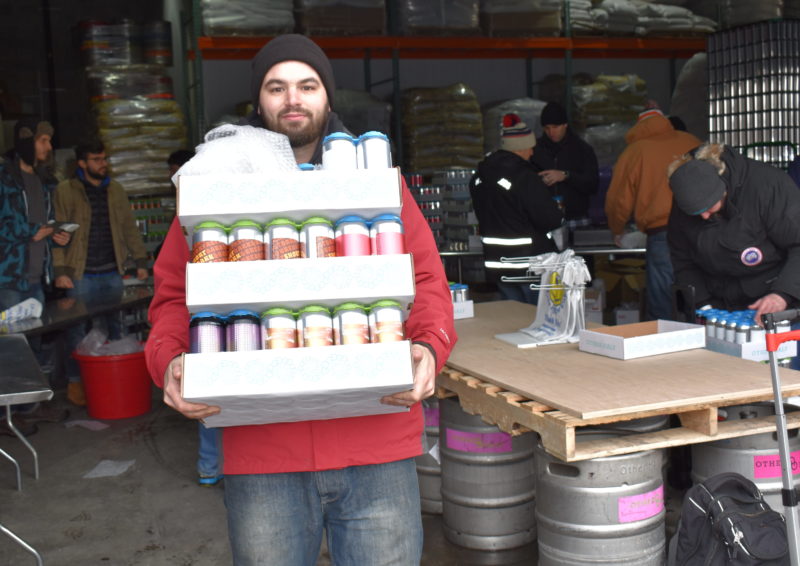
Jesse Sayre hauls away his beer purchase after waiting in line for nearly eight hours one recent Saturday at Other Half Brewing (Photo by Steve Koepp)
Temperatures were in the low 20s one recent Saturday at 1:40 a.m. when Jesse Sayre of Port Jefferson, Long Island, took up his place on line. It was a lonely warehouse block in Carroll Gardens right by a metal scrapyard, but Sayre had some company, since Lou Ney of Pennsylvania snagged first spot in line around midnight, he said. By 10 a.m., with the rising sun warming things up a bit, the No. 1 and 2 placeholders had been joined by hundreds of other people outfitted with folding chairs, hand trucks and many layers of warm clothing.
What had attracted all these hardy, patient folks? Not concert tickets or affordable housing, but something more pedestrian, at least at first blush: beer. But this beer, brewed on premises at 195 Centre St. by Other Half Brewing Co., is a premium product, typically priced at $5 a can. For taste alone, the beer is evidently worth it, ranking as “exceptional” in cumulative reviews on Beer Advocate. “The beer is good, so you know what you came for,” says Ney. “It’s really well-made beer.”
But there’s even more at work here. Other Half makes beer that its customers want to talk about–and gives them a place to do it, both online and on line, the waiting kind. It’s craft beer as entertainment and shared social experience. The folks queuing up for hours call it “line sharing,” which means swapping beers and stories while waiting for their chance to buy a limited release of a unique brew that only a few people will get their hands on.
“I’ve have been coming to the can releases every week for two years,” says Sayre, 31, the chief engineer for a radio-broadcasting company. “This is my Saturday with the boys. I put my kid to bed and come here.” Pat Newman, a line-sharing pal of Sayre’s who drives in from Lyndhurst, N.J., says the waiting is part of the draw. “It’s fun to hang out. I could stay at a bar till 5 a.m., or I could wait on line here. Same thing.”
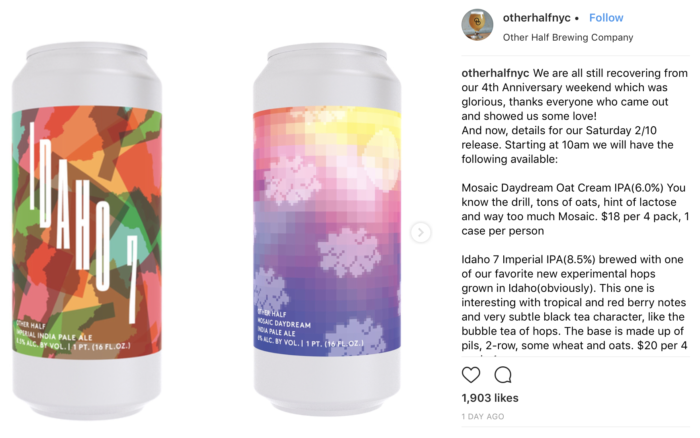
In a post from Other Half’s Instagram account, the brewery previews this weekend’s limited releases (Other Half Brewing, via Instagram)
The almost religious following of craft beers, notably India Pale Ale (IPA), has been building for several years, but few places have caught the wave like Other Half. The brewery opened in January 2014 with a combined brewhouse and tiny taproom with a deer head on the wall. Four years later, the facility has expanded to take up nearly the entire block–and it’s still too small to meet demand, says Andrew Burman, one of the brewery’s three partners. “Every week we have somewhere between 1,500 and 2,000 people come through the tap room. The majority of that is on Saturdays, but it’s a staggering number.”
One could say that Other Half’s quick rise has been driven by three Cs: creativity, craftsmanship and communication. Every new brew recipe–Beer Advocate lists more than 240 by Other Half–is a fresh concoction of grains and hops with a quirky name (Alternate Side Zamboni, Twice Baked Potato), packaged in cans with one-of-a-kind graphics, and shared energetically on social media.
In The Bridge’s exclusive ranking of Brooklyn’s 20 breweries according to social-media following (see below), Other Half ranks No. 3 behind two brands that got a much longer head start, Brooklyn Brewery (1988) and Sixpoint Brewery (2004). Other Half now has 100,000 followers on Instagram and 138,000 total, including Facebook and Twitter. “The Instagram thing has been super helpful to us,” says Burman. “It’s amazing. Somehow we’ve just grown exponentially with it.”
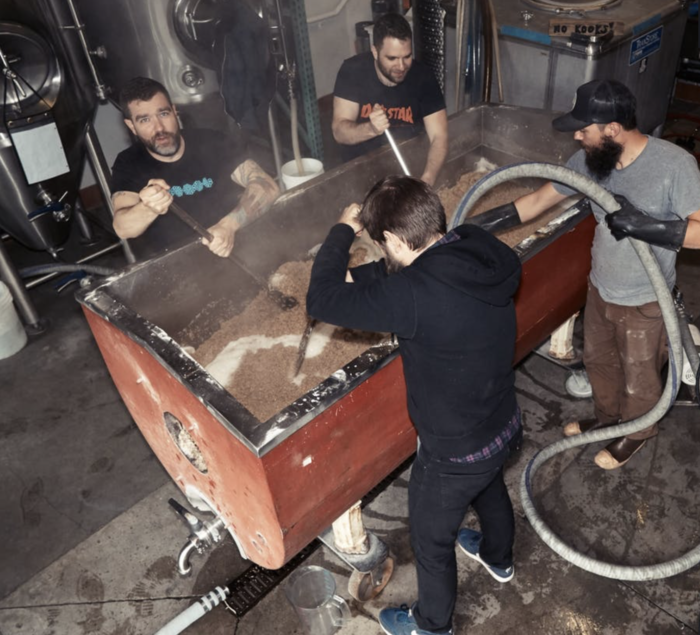
Other Half’s brewers at work in their Carroll Gardens complex (Photo courtesy of Other Half Brewing)
Drawing huge crowds, digitally and in person, was not the original business plan. “It completely evolved. We’re not quite sure how this all happened,” says Burman. The three founders envisioned a company that would be part of the “other half” of the industry, meaning people obsessed with beer in all its abundant variety. “We weren’t really satisfied with the status quo of what a brewery was,” he says. “Not to mention any names or anything, but there are certain breweries that are craft brewing and they’re a little old and stodgy and not that stylish. We want more from a brand.”
Sam Richardson was the first of the trio into the brewing business, working at Greenpoint Beer & Ale Co. when he met Burman and Matt Monahan, both chefs aiming to become brewers. “We worked together in various capacities cooking for about four or five years and were always dreaming about what we were going to open,” recalls Burman, but eventually they realized that their dream could become a nightmare of a lifestyle. “It’s really hard. Restaurants are the worst kind of business.”
The trio brewed their first batches to accompany the food at events they were catering. When word of their beer got around, restaurants started asking them to brew custom batches. Growing confident in their brewmastery, the trio pulled together some funding and found the space for their brewhouse on Craigslist.
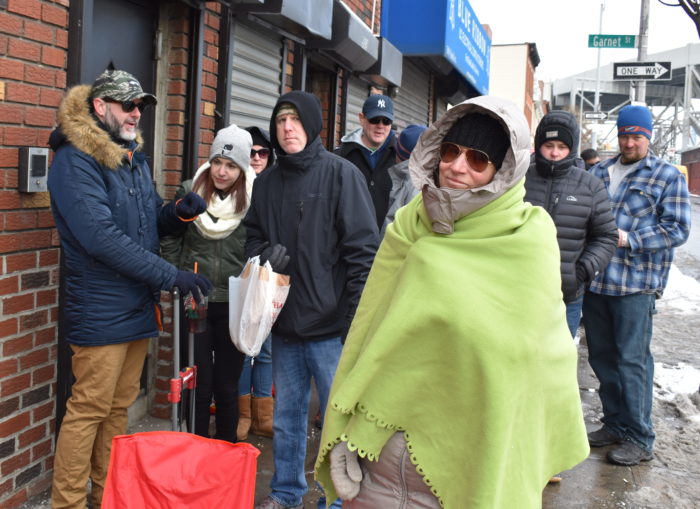
Other Half customers bundled up to keep warm for a recent can release (Photo by Steve Koepp)
The place was anonymous-looking at first, with just a tiny logo on the door, but the beer was anything but. The brewers quickly developed a reputation for intensely hoppy brews like Green Diamonds, an Imperial IPA packing a potent 9.1% alcohol by volume (ABV), with strong pine-resin notes. Before long, millennial IPA fanatics began making Saturday pilgrimages to the little brewery on Centre Street.
Once they got the party started, the brewers needed to keep it rolling via constant re-invention. Each one of the partners has a distinct role in that process. Richardson handles recipe development and “how we differentiate ourself from everybody else,” says Burman. “And he does all the labels and naming of the beers, which is a very large task.” Monahan handles strategic planning and Burman handles day-to-day operations. “I like that stuff. I enjoy those things that actually make it work,” he says.
The partners quickly recognized that the visuals are an important part of their branding. They get expert help on the graphics from a Brooklyn-dwelling husband-and-wife team called Small Stuff, as well as website design by Craftpeak, a North Carolina company that specializes in serving the craft-brewing industry. The sparkling photos that go on Other Half’s Instagram account are typically shot by a professional photographer.
All this distinctiveness makes Other Half products eminently collectible. The cans are sold in limited editions, not unlike the way street-fashion brands create scarcity and a market for swapping and reselling the product. Other Half cans are “trade gold,” says superfan Sayre, who often swaps them for collectibles from Monkish Brewing, a California brand with a similar following. “This is like adult baseball cards,” he says–or Pokémon. “Pokémon is Catch ‘Em All, Other Half is Drink ‘Em All.”
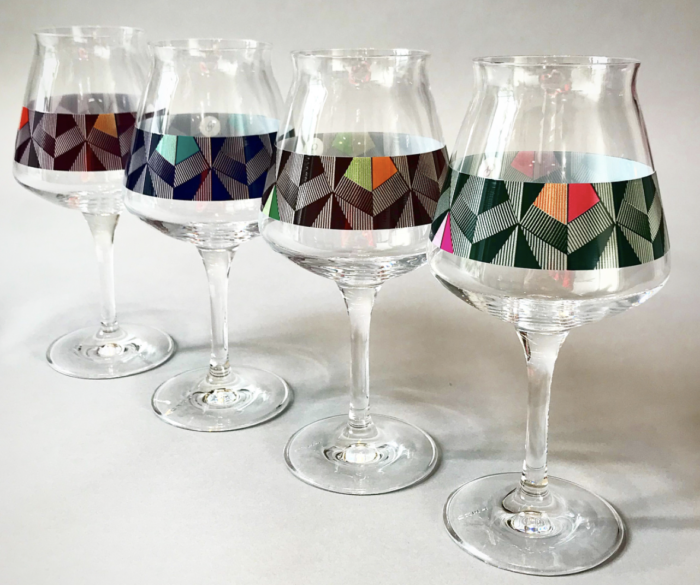
The brewery also sells accessories and glassware like these teku glasses in limited editions. The glasses cost $15 each, but collectors often resell them at a premium (Photo courtesy of Other Half via Instagram)
For a typical can-release day, Other Half will brew about four different types, with a canning run of around 200 cases each. Customers are usually limited to one case of each brew, which contains six four-packs. At around $120 per case, customers who cart off their four-case maximum have invested a tidy sum. The day’s releases are usually notable for their variety; one recent day featured an Imperial IPA, two double dry-hopped IPAs and a stout called Short, Dark and Breakfast, made with coffee, lactose and maple syrup.
Because can releases have become major events, Other Half takes crowd control seriously, sometimes even hiring security guards to keep an eye on the line during the night before, says Burman, whose duties include line-wrangling. “When I walk the line every Saturday morning, I will tell everybody that there’s 400 allotments of this beer, you are number 347–you will get the beer, I promise you’ll get the beer. It’s going to take an hour and 30 minutes,” say Burman. “Once you’re here, we’re very, very honest.”
Customers tend to be patient because they’ve turned the wait into a kind of tailgating party, showing up regularly with groups of friends. “One line-sharer will be opening up oysters and another one will have bought donuts for everyone. It’s really cute,” says Burman. Customers who don’t want to wait on line can go straight to the tap room, where they can buy beer by the glass or growler.
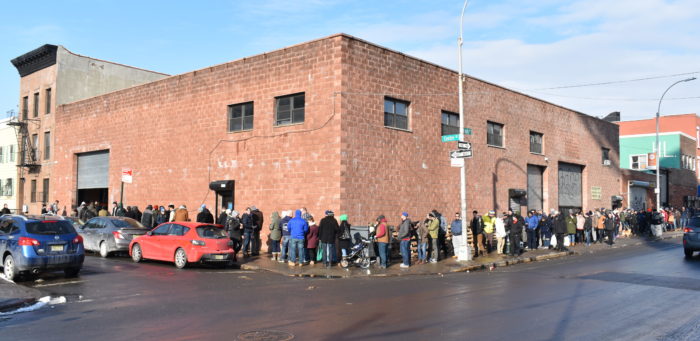
At the brewhouse and taproom, the line stretched around the block–and then some (Photo by Steve Koepp)
The brewers are conscious of being a suddenly big presence in a quiet neighborhood. “It’s mostly a commercial block, but when you go around the block, there’s a nursing home on the other side,” Burman notes. Once the line hits that point, the brewers try to speed up the process. “It’s not fair to people on a Saturday morning when they’re trying to sleep and there’s a bunch of dudes outside, shooting the shit.”
To keep themselves fresh, the brewers try to get out of the neighborhood periodically for collaborations with other brewers, which has included trips to Copenhagen and Padua, Italy, where they made a wine-based beer. When they sell releases based on the collaborations, it makes a good story and boosts the intensity of fan demand. “We really want to make sure the people are experiencing more than just beer,” says Burman.
As Other Half grows, it will need to expand its facilities–all of them rented so far. “That’s something we talk about all the time. I don’t think we’ll ever be big enough to move, but we’ll be big enough to add another facility somewhere else. We’ll always have Centre Street. It’s a great location, really Brooklyn-y, it’s really us,” says Burman. “And it’s sort of like, your first place–you never really want to get rid of it.” And maybe the best part for these former chefs is that it’s not a restaurant.
Exclusive: we’ve compiled a list of brewers in Brooklyn’s booming craft-beer industry, ranking 20 brewers by their social-media following, which has become the primary way for fans to discover new products. (For capsule profiles of more than a dozen newcomers, see our story on award-winning Threes Brewing.) If you see any errors or omissions on our list, please let us know at editor@thebridgebk.com and we’ll make a prompt update.










